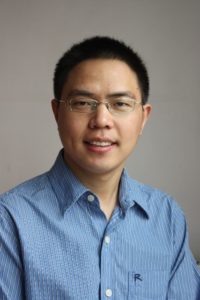We are delighted to introduce our latest Environmental Science: Nano Emerging Investigator, Jingkun Jiang!
Dr. Jingkun Jiang is a professor at School of Environment, Tsinghua University. He received a BS and a MS in Environmental Science and Engineering from Tsinghua University. He holds a PhD degree in Energy, Environmental and Chemical Engineering from Washington University in St. Louis. Prior to joining Tsinghua in 2010, he worked as a Postdoctoral Research Associate in the Particle Technology Laboratory of Mechanical Engineering Department, University of Minnesota.
Dr. Jiang’s research activities involve various topics in aerosol science and technology. He has published 90 peer-reviewed journal articles. He received a number of awards including Smoluchowski award (2018), Asian Young Aerosol Scientist Award (2015), and A&WMA Doctoral Dissertation Award (2009). He is serving as an editor for Aerosol Science & Technology, a guest editor for Atmospheric Chemistry & Physics, an editorial board member for Journal of Aerosol Science, and the deputy director for State Key Joint Laboratory of Environment Simulation and Pollution Control.
Read his recent Emerging Investigator Series article: “Dispersed transition metals on a nitrogen-doped carbon nanoframework for environmental hydrogen peroxide detection” and find out more about him in his interview below:
Your recent Emerging Investigator Series paper focuses on environmental hydrogen peroxide detection using a nitrogen doped carbon nanoframework. How has your research evolved from your first article to this most recent article?
My first article as the leading author is entitled “model for nanoparticle charging by diffusion, direct photoionization, and thermionization mechanisms”. Over the years, our research activities have involved various topics in aerosol science and technology: aerosol instrumentation; particle formation and emission from combustion sources; atmospheric new particle formation; synthesis and application of aerosol nanoparticles; aerosol nanotoxicology; metagenomics of airborne microorganism.
What aspect of your work are you most excited about at the moment?
The most excited aspect is to work with talented students to address questions that have puzzled me and others for years.
In your opinion, what is the biggest advantage of the presented method for the detection of H2O2 over traditional methods?
A grand challenge for many disciplines is to develop/adopt emerging data acquisition technologies (e.g. sensors) and big-data analysis. In comparison to traditional methods, the presented method is an example towards this direction using nanotechnologies.
What do you find most challenging about your research?
Finding a balance between working (research, teaching, and service) and spending time with family.
In which upcoming conferences or events may our readers meet you?
International aerosol conference 2018; Asian aerosol conference 2019; European aerosol conference 2019
How do you spend your spare time?
Spending time with family and playing with kids; biking; traveling.
Which profession would you choose if you were not a scientist?
A farmer
Can you share one piece of career-related advice or wisdom with other early career scientists?
Understand that the challenges can be different when working in different countries and stay focused at the beginning.











